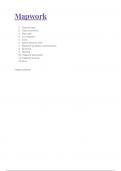Summary
Summary IEB/NSC - Geo - Mapwork
- Module
- Institution
Map work Techniques • applying map skills and techniques: scale, contours, cross-sections, position, distance, area • direction: magnetic north, true north, bearing and concept of magnetic declination • grid referencing • map and photo interpretation, including: reading and analysis of ...
[Show more]



